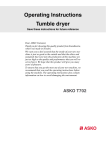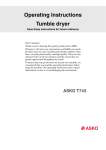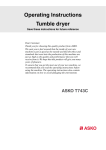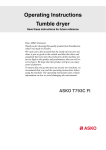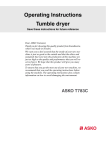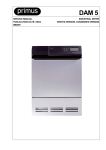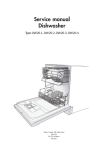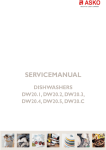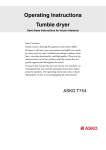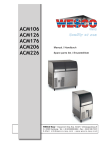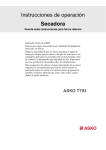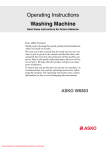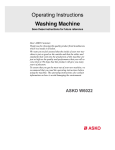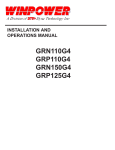Download Wesco T504 Operating instructions
Transcript
Manual / Handbuch Spare parts list / Ersatzteilliste Equipment Imp.-Exp. GmbH • Zitterpappelweg 9 D - 22391 Hamburg • Tel.: + 49 40 60009468-0 • Fax: + 49 40 536 75 01 E - M a i l : i n f o @ w e s c o - n a v y. c o m • w w w . w e s c o - n a v y. c o m • Contents Before using your machine for the first time Do not tumble dry Important safety instructions Installation Grounding instructions Interrupting a program Packing material Disposal Child safety General Description of the tumble dryer Front panel Options button Advice and tips before you tumble dry Have the clothes been spun? Materials that can be tumble dried Materials that should not be tumble dried Static electricity Operating instructions Sort your fabrics Turn on the main power switch. Open the door, load the items, and then close the door Select the program Selecting Options Press the Start button Drying program finished Once drying has finished Care and maintenance instructions Cleaning the lint filter Cleaning the outside of the machine 3 3 4 4 5 5 5 5 6 6 7 8 8 9 9 9 9 9 10 10 10 10 10 12 13 13 14 15 15 15 Troubleshooting The machine will not start Overheating cut-off Drying takes too long The laundry does not dry, or is too dry Technical information Technical data Service and guarantee Warranty How to contact the ASKO Appliances Inc. Installation instructions Positioning the tumble dryer Adjusting the feet Air exhaust Electrical installation Reversing the door Reversing the door Quick guide Fabrics Turn on the main power switch Load the laundry Select a program and any options Press the Start/Stop button Drying program finished Once tumble drying has finished 16 16 16 16 16 17 17 18 19 19 20 20 23 23 25 28 28 32 32 32 32 32 32 32 32 Before using your machine for the first time Do you need this Use&Care Guide in spanish? Log onto www.askousa.com/customercare to download. ¿Necesita esta Instrucciones de uso y cuidado en español? Entre en www.askousa.com/customercare y descárguesela. Do not tumble dry Certain materials are not suitable for tumble drying. Always check and follow the instructions on each item's laundry label. You can find more information in the "Advice and tips before you tumble dry" chapter. Note! When starting the tumble dryer for the first time or after a long period without use, you may hear a slight thumping noise. This noise is completely normal and will disappear after a few loads. See the Quick guide on the last page. Important safety instructions Save these instructions for future reference Installation See the "Installation" chapter. Warning! WARNING - To reduce the risk of fire, electric shock, or injury to persons when using your appliance, follow basic precautions, including the following: • Read all instructions before using the appliance. • Do not wash or dry articles that have been previously cleaned in, washed in, soaked in, or spotted with gasoline, dry-cleaning solvents, cooking oils, other flammable or explosive substances as they give off vapors that could ignite or explode. • Do not allow children to play on or in the appliance. Children should be closely supervised when near the appliance. • Before the appliance is removed from service or discarded, remove the door to the drying compartment. • Do not reach into the appliance if the drum is moving. • Do not install or store this appliance where it will be exposed to the weather. • Do not tamper with controls. • Do not attempt to repair or replace any part of the appliance or perform any servicing unless specifically recommended in this guide. • Do not use fabric softeners or dryer sheets unless the manufacturer gives written assurance that the product will not damage a tumble dryer. • Do not heat-dry items containing: vinyl, plastic, foam rubber or similarly textured rubberlike materials, fiberglass, or wool unless wool unless the label specifies “washable”. • Clean the lint filter before or after each load. • Keep the area around the exhaust opening and adjacent surrounding areas free from the accumulation of lint, dust and dirt. • The interior of the machine should be cleaned periodically by an authorized ASKO service agent. • Do not place items exposed to cooking oils in your dryer. Items contaminated with cooking oils may contribute to a chemical reaction that could cause a load to catch fire. • Electrical installation, if required, must be done by a licensed electrician. • Do not operate appliance while away from the home. • Do not heat dry items that have been drycleaned. • The dryer is made and marked to facilitate recycling. When it is no longer useful, contact your local refuse collection service for advice on how to properly dispose of the dryer for purposes of recycling. • Damaged power cables should only be replaced by a certified professional. • Provide sufficient ventilation, otherwise smoke from open fires or fumes from equipment burning other fuels can be drawn into the room. Caution! During the program, the back of the dryer will get very hot. Let the machine cool completely before touching the back. Warning! This appliance must be properly grounded. Important safety instructions Grounding instructions A) Grounding instructions for a grounded, cord-connected appliance In the event of malfunction or breakdown, grounding will reduce the risk of electric shock by providing a path of least resistance for electric current. This appliance (Canadian market only) is equipped with a cord having an equipmentgrounding conductor and a grounding plug. The plug must be plugged into an appropriate outlet that is properly installed and grounded in accordance with all local codes and ordinances. Warning! B) Grounding instructions for a permanently connected appliance: This appliance must be connected to a grounded metal, permanent wiring system, or an equipmentgrounding conductor must be run with the circuit conductors and connected to the equipmentgrounding terminal or lead on the appliance. Note This manual does not cover every possible condition and situation that may occur. Use common sense and caution when installing, operating, and maintaining any appliance. Interrupting a program Improper connection of the equipment-grounding conductor can result in a risk of electric shock. Check with a qualified electrician or service representative or personnel if you are in doubt as to whether the appliance is properly grounded. Do not modify the plug provided with the appliance (Canadian market only). If it will not fit the outlet, have a proper outlet installed by a qualified electrician. You can stop a drying program by: • Opening the door. The drum will then stop automatically. • Pressing the main power switch. • Press the Start/Stop button for three seconds. To reduce the risk of fire, this appliance must be exhausted outdoors or the equivalent. Do not exhaust into a chimney, wall, ceiling or concealed space in a building. Please sort waste materials in accordance with local guidelines. When you want to resume tumble drying, simply close the door and press the Start/Stop button. Packing material Disposal This machine is manufactured and labeled for recycling. In order to prevent injuries, the machine must be made unusable once the decision has been made to dispose of it. Contact your municipality for information about where and how your machine can be recycled correctly. Save these instructions for future reference Child safety General Do not allow children to play with the tumble dryer. The tumble dryer does not start automatically when the door closes (for example, if a child closes the door from inside). The tumble dryer has a magnetic catch, which allows the door to be opened from the inside. The door has a door switch that automatically stops the tumble dryer when the door is opened. Description of the tumble dryer 1 2 3 4 5 1. Panel 4. Outer door 2. Serial number tag and rating plate 3. Lint filter holder 5. Fan (behind the front plate) 6. Lint filter 96 Front panel 1 5 2 3 4 1. Main power switch 2-4 Options buttons 5. Program selector 6. Display 7. Start/Stop Options button 2 2. Button for selecting Low Temperature 3. Button for selecting Anti Wrinkle 4. Button for selecting Delayed Start 1-24h 3 4 6 7 Advice and tips before you tumble dry Here are some tips that may help you before you begin tumble drying. Materials that should not be tumble dried Have the clothes been spun? This symbol means that the material is not suitable for tumble drying. Certain materials may melt or become a fire hazard if exposed to heat and others can lose their shape or shrink. Items to be tumble dried should be spun at 1000 rpm or faster. Higher spin speeds save both energy and drying time. Materials that can be tumble dried This symbol means that the material is suitable for tumble drying. Fabrics best suited to tumble drying are cotton fabrics, terry cloth, and synthetic fibers. Garments will be softer and lighter when tumbled than when hung out to dry. And do not tumble dry • • • • • materials labeled "Do not dry near heat". garments that have been dry-cleaned at home. plastic foam. fiberglass material. wool must not be tumble dried due to the risk of piling. Note! Static electricity The tumble dryer does not cause any significant wear to fabrics. The lint trapped in the lint filter consists of dust and fiber residues which gather when the items are used. To reduce the risk of static electricity in the laundry after tumble drying, you can: • Use fabric softener when washing. • Wait five minutes after the drying program ends before opening the door and removing the laundry from the dryer. Note! If the door is opened during the program, the program will be interrupted and will return to the start. The clothes may be too damp or too dry as a result. Operating instructions Warning! To reduce the risk of electric shock or injury to persons, read the "Important Safety Instructions" section before operating this appliance. Below are step-by-step instructions to help you achieve the best possible tumble drying results. 1 Sort your fabrics Auto Normal and Auto Delicate These programs shut off the heat once the load is dry but before it is "bone-dry". The Auto Normal program shuts off the heat slightly later than Auto Delicate. Use trial and error to find out what works best. Use these programs when you want items to be completely dry. Auto Iron Dry You will achieve the most uniform drying results if the items are made of the same type of material. Close zippers and fasten buttons or belts; sort the items and adjust load and temperature. This program shuts off the heat once the load is just damp enough for ironing or pressing. 2 3 4 Air Fluff Turn on the main power switch. Open the door, load the items, and then close the door Select the program The choice of program depends on what you intend to do with the items after drying them. Guidelines as to what specific programs can be used for. Auto Normal Auto Delicate Auto Heavy Auto Iron Dry Timed Dry Air Fluff Auto Heavy This program is for items that are particularly difficult to dry, such as jeans with very thick seams. Note! Knitted fabrics in particular are prone to shrinkage. Use the Auto Normal, Auto Delicate, or Auto Iron Dry programs for these items. Stretch clothes back into shape immediately after drying. Timed Dry The Timed Dry program has a fixed drying time and tumble dries the load for 60 minutes. Use the Air Fluff program when you just want to refresh, air out,, or soften up items. Operating instructions Program chart Here we present a few examples of the energy and time consumption of a few different program settings. Consumption can vary due to room temperature, humidity, load, variations in the power supply, and selected options For the consumption values given below, the requirements are as follows: Temperature of intake air: 73°F (23°C) Moisture content of intake air: 55 % Drying temperature: Normal or Low Heater output: 3000W Program chart Program Material Temperature Max. load (lb) Auto Heavy Cotton, linen Normal 13 Energy consumption (approx. kWh) Program time (approx. hrs and min.) 800 rpm 1600 rpm 800 rpm 1600 rpm 4.1 3.2 2:10 1:45 Auto Normal Cotton, linen Normal 13 3.7 2.9 2:00 1:30 Auto Normal Wrinkle-resistant, polyester/cotton Normal 7 1.6 - 0:50 - Auto Delicate Cotton, linen 1) Normal 13 3.5 2.6 1:50 1:25 Auto Delicate Wrinkle-resistant, polyester/cotton Normal 7 1.5 - 0:50 - Auto Delicate Acrylic, rayon, acetate Low 7 1.8 - 0:55 - Auto Iron Dry Cotton, linen Normal 13 2.8 1.9 1:25 0:55 Operating instructions 5 Selecting Options By selecting options, you can tailor drying programs to suit your own laundry requirements. The machine remembers the selected option and uses it the next time you select the same program. You can, of course, change this if you want. Low Temperature Select or deselect Low Temperature by pressing the Temperature button. Once Low Temperature has been selected, the red field next to the button lights up. Anti Wrinkle This option will cause the drum to rotate for three seconds each minute for two hours once the drying program has finished. This prevents the items remaining in the same position and becoming wrinkled. This is a useful feature if you are not able to remove the load as soon as tumble drying has finished. A lighted red field next to the button indicates that the Anti Wrinkle option has been activated. Delayed Start When you select Delayed Start, the machine will start 1-24 hours after you press the Start/Stop button. • Press the Delayed Start button the same number of times as the number of hours by which you want to delay the start (1-24 hours). A lighted red field next to the button indicates that the option has been activated. • The number of hours delay until start is shown on the display. • Press the Start/Stop button. • The number of hours to start is displayed with a countdown one hour at a time. • Cancel Delayed Start by pressing the Start/Stop button for 3 seconds. The red field will go out. • Select a program and press the Start/Stop button. Important! Remember to press the Start/Stop button to start the program. Operating instructions 6 Press the Start button Remaining drying time An estimate of the remaining drying time will be shown on the display a few minutes after the drying program starts. For example, 1:35 means it will take approximately 1 hour and 35 minutes for the load to dry. If the Anti Wrinkle option has been selected, the drum will rotate for 3 seconds every minute for 2 hours after the program is finished. Stopping or changing a program Press and hold the Start/Stop button for three seconds. The red field next to the button will go out. Note! The program will not be affected if you change the program selector after the program has started. Loading or removing laundry If you want to load or remove laundry once you have started the machine, open the door and the program will stop. Load more laundry or take out the items you want, close the door, and press the Start/Stop button. 7 Drying program finished The text "END" appears on the display when the program is finished. If the Anti Wrinkle option has been selected, the drum will rotate for 3 seconds every minute for 2 hours after the program is finished. Important! • Clean the lint filter after each load. Caution! If the lint filter becomes clogged, the machine’s automatic overheating cut-off may be triggered. In order to be able to restart the machine, you must clean the filter and allow the machine to cool down for around 30 minutes. Cleaning the lint filter 1. Grasp the filter handle and pull it toward you. 2. Pull the filter out of its holder. ! 3. Open the filter and remove the lint by hand. 4. Fold the filter up and insert it into its holder. The filter may need to be cleaned if it has limescale deposits. See the "Care and cleaning" chapter. Operating instructions To install the automatic drain hose, please see the section titled Installation 8 Once drying has finished Turn off the main power switch. Remove the clothes and close the door to prevent small children from climbing into the machine. Care and maintenance instructions Cleaning the lint filter Cleaning the outside of the machine The lint filter must be cleaned after each load. If you have very hard water, this can cause limescale deposits in the lint filter. Check for any limescale deposits when cleaning the lint filter and, if necessary, wash the filter by hand. Additionally, the filter should be cleaned with hot water, detergent, and a soft brush quarterly. 1. Grasp the filter handle and pull it toward you. 2. Pull the filter out of its holder. Clean the outside of the machine and the program panel with a mild cleaner. Do not use solvents, as these can damage the machine. Do not hose down or spray the machine with water. ! 3. Open the filter and remove the lint from all sides of it by hand. Use a soft, dry cloth to remove any deposits. 4. Replace the filter in its holder. Note! If you have hard water, the filter should be washed with water to remove any limescale deposits. Use a sponge and a little dishwashing detergent if necessary. Dry the filter carefully with a towel. If you cannot remove the limescale, you can buy a new filter from the retailer where you bought the tumble dryer. Note! Do not allow dust to accumulate around the machine. Keep the area around the tumble dryer clean and cool; dust, heat, and moisture prolong drying times. Troubleshooting The machine will not start Overheating cut-off Check • that the door is properly closed. • that the main power switch is on. • that the Delayed Start option has not been selected. If so, the time remaining until start will be shown in full hours on the display (e.g., 5, 4, 3h). To cancel Delayed Start, press the Start/Stop button for 3 seconds. • that any plug is connected. • that the fuses (circuit breakers) in your house are intact. Flip the dryer breaker off and then back on to make sure. You can not always tell from the outside if the circuit breaker has tripped. • that the overheating cut-off has not been triggered (see below). The overheating cut-off shuts off the tumble dryer if the temperature is too high, caused by lint clogging the lint filter, for instance. • Clean the filter. • The overheating cut-off will reset automatically once the machine has cooled down. Drying takes too long • Check that the lint filter is not clogged (see the "Care and maintenance" chapter). The laundry does not dry, or is too dry • The door has been opened while the program is running, which disrupts the moisture monitoring function. Technical information Technical data Height: Width: Depth: Weight: Cylinder volume: Max. drying capacity: Speed: Rated power: Drum material: Outer casing material: Setup Drain: 33 1/2'' (850mm) 23 7/16'' (595mm) 23,0" (585mm) 104lb (47kg) 29,3gal (111l) 13lb (6kg) 52 rpm See serial number tag and rating plate. Stainless steel Powder-coated and hot-galvanized sheet steel or stainless steel. Stacking or freestanding 67" (1.7m) polypropylene hose Installation instructions WARNING! WARNING - Risk of fire. Install the clothes dryer according to the manufacturer's instructions and local codes. Do not install a clothes dryer with flexible plastic venting materials. If flexible metal (foil type) duct is installed, it must be of a specific type identified by the applience manufacturer as suitable for use with clothes dryers. Flexible venting materials are known to collapse, be easily crushed, and trap lint. These conditions will obstruct clothes dryer airflow and increase the risk of fire. To reduce the risk of of severe injury or death, follow all installation instructions. Save these instructions for future reference. Positioning the tumble dryer The tumble dryer can be freestanding or stacked. Remember that the tumble dryer produces heat and should therefore not be located in a room that is too small. If the room is very small, drying will take longer due to the limited quantity of air. Caution! For proper ventilation, the machine should not be installed behind a door. Caution! The tumble dryer's toe kick ventilation must not be blocked by a rug or the like. Tip! If the unit must be installed behind a door should be louvered. To improve ventilation, the door where the tumble dryer is located should be left open when the dryer is in use. Caution! Clothes dryer installation must be performed by a qualified installer. A. Freestanding The tumble dryer can be positioned beside the washing machine. B. Stacked The tumble dryer can be placed on top of a ASKO washing machine. To stack the dryer, you need the stacking attachments (foot cups and anti-tip devices) that come with the machine: You will find 2 foot cups in a bag in the drum and 2 anti-tip devices attached to the bottom left corner at the back of the machine. Extension plates can be ordered from your local retailer. Installation instructions C. Built-in ASKO dryers can be installed beneath a cabinet or worktop with a minimum height of 34” (864 mm). There must be a gap of about 1/2” (12 mm) all around the machine, including between the rear edge of the machine top panel and the back wall. The opening width must be at least 24-1/2” (622 mm). The condensing models work best when they have good air circulation. Install the dryer so the condensed water will continuously flow into a drain or sink, you will need a drain outlet behind the unit. The maximum drain height is 40” (1016 mm). Notes The height adjustment for the dryer is 33-1/2” to 34-1/2” (850 mm to 876 mm). Do not raise it higher than 34-1/2” (876 mm). Hole measurements are from center of hole. Installation instructions How to assemble the stacking kit: 1. Undo the anti-tip device. 2. Remove the two screws indicated on the back of the washing machine. 5. Fit the plastic cups so that the "tags" marked with arrows are against the front edge or side edge of the cover and press them firmly onto the cover. Then break off the remaining tabs. 6. Push out the knock-out hole on the back of the dryer (you don't have to completely remove the knockout, just fold it up far enough for the stacking bracket to fit inside the slot) using a hammer and screwdriver. 3. Secure the anti-tip device using the screws as shown in the picture. 7. Push the tumble dryer in under the metal brackets. At the same time, keep the front edge raised by 0,4" (10mm) to 0,8" (20mm). 4. Attach the plastic cups for mounting the tumble dryer’s front feet to the washing machine’s top cover. This is essential, as only when the tumble dryer’s feet are resting in the plastic cups can you be sure that the dryer is correctly positioned on the washing machine. Break off tab A on the cup fitted on the right side and tab B on the cup fitted on the left side. Then remove the paper from the self-adhesive surface under the plastic cups. A A BB 8. Lower the tumble dryer’s front feet into the plastic cups and adjust the dryer to ensure that it is balanced. Installation instructions Adjusting the feet Screw the feet in or out so that the tumble dryer is steady and balanced on the floor or on the washing machine. Then tighten the lock nuts. Lock nut Air exhaust Connecting the exhaust duct to the dryer Note You will need to purchase a UL-CSA-approved 4-inch ridged metal exhaust duct. The dryer is delivered with the stub pipeattached to the rear exhaust outlet, but the exhaust duct can be attached to either the right or left exhaust outlet. Asko dryers have a “T-stile” exhaust vent that allows you to connect the duct on the rear or on the left or right side. Vent T-tube Rear Exhaust Outlet Side Exhaust Outlet Stub Clamp (not supplied) Duct The duct must not be assembled with screws or other fastenings that extend into the duct and trap lint. To connect the exhaust duct to the rear outlet To connect the exhaust duct to the rear outlet, follow the steps below:. 1. Push the duct onto the stub pipe and secure it with a clamp 2. With the duct attached, insert the stub pipe into the hole. It should snap into place. 3. After you push the dryer into place, check for kinks in the duct. Note Excessive duct length and too many bends can impede drying performance. We recommend that you cut off any excess exhaust duct and run the duct with as few bends as possible. Make any necessary bends as gentle as possible. Note Maximum duct length of 60 feet and 4 elbows is allowed. Subtract 4 feet of duct for each 90° elbow. Installation instructions Connecting the exhaust duct to the Left or Right Side Outlet To connect the exhaust duct to the left or right side outlet, follow the steps below: 1. Using a flathead screw-driver, turn the exhaust outlet cover you plan to use to the right or left to align the tabs holding the cover in place. 2. Remove the exhaust outlet cover. 3. Remove the stub pipe from the rear exhaust outlet and place it in the outlet you plan to use. 4. Push the duct onto the stub pipe and secure it with a clamp. 5. With the duct attached, insert the stub pipe into the hole. It should snap into place. 6. After you push the dryer into place, check for kinks in the duct. 7. Use the exhaust outlet cover you removed from the to cover the rear exhaust outlet. Warning! To reduce the risk of fire, this appliance must be exhausted OUTDOORS or the equivalent. Never cover the end of the dryer stub or exhaust duct with anything to catch lint, except for UL approved vent basket. Connecting to a ventilation duct You will need a UL-CSA-approved, 4-inch ridged metal exhaust duct. If a flexible duct is used, it must comply with the Outline for Clothes Dryer Transition Duct. Subject 2158A and maximum length of 2.4 m (8 feet). Note The more bends and the longer the duct, the less air will circulate through the machine, which will impede drying performance. We recommend that you cut off any excess exhaust duct and run the duct with as few bends as possible. And make any necessary bends as gentle as possible. Note Maximum duct length of 60 feet and 4 elbows is allowed. Subtract 4 feet of duct for each 90° elbow. If more than 20 feet of duct is needed, the diameter must be increased to 6” or 8” (152 mm or 203 mm). Note When installing in warm climates (77° F and above) with high humidity levels, do not route the air exhaust duct upwards. Examples of installations subtract 4 feet for every 90° elbow Installation instructions To connect the exhaust duct to a ventilation outlet, follow the steps below: 1. Connect the exhaust duct to a ventilation exhaust fitting or to a discharge through the wall. 2. Secure the duct joint to the outlet stub on the machine. 3. Run the duct with as few bends as possible to the point of discharge. Electrical installation Warning! The receptacle on the rear of the machine is designed to accommodate ASKO washers ONLY (rated 208–240 V.) To use this receptacle, you must use the ready-fitted plug supplied with the washing machine or an equivalent. ASKO washers rated 208–240 V have two internal fuses of 15 A each. Ventilation grill The machine should only be connected to a grounded wall socket. Warning! This appliance must be properly grounded. Refer to the “Important Safety Instructions” for grounding instructions. Make sure nothing is blocking the ventill Warning! This appliance shall not be exhausted into a chimney, a wall, a ceiling, an attic, a crawl space or a concealed space of a building. Only a rigid or flexible metal duct shall be used for exhausting. Only a metal ventilation grill shall be used. If the duct is taken to a wall outlet, a ventilation grill shall be fitted to prevent reverse flow of cold air. Fit the ventilation grill to the outside or inside of the wall. If there is only one vent duct from the room, a vent spacer must be fitted. Vent spacer The power supply cord must be grounded. If the machine is to be used in a wet area, the supply must be protected by a residual current device. Connection to a permanently wired supply point must be made only by a qualified electrician. As supplied: Single-phase, 230 V, 60 Hz, 3000W heater rating 30 A circuit required Remove cover to access terminal box. (Requires a 20-Torx screwdriver.) Installation instructions Electrical Connections Connecting a 3-wire Power Cord Warning! Warning! Read the Electrical requirements and grounding instructions before connecting the tumble dryer. Before starting this procedure, be sure the power is turned off at the breaker/fuse box. Electric models of the dryer are manufactured for a 3-wire connection system. The dryer frame is grounded by a link to the neutral conductor on the dryer terminal block. If local codes do not permit grounding through the neutral, the grounding link from the terminal block must be removed and a separate ground wire must be used. Only a 4-conductor cord shall be used when the applience is installed in a location where grounding through the neutral conductor i prohibited. Grounding through the neutral conductor is prohibited for new branch-circuit installations, mobile homes, recreational vehicles, and areas where local codes prohibit grounding through the neutral condutors. The grounding link on the dryer must be removed for all 4-wire installations. These Electrical Connection instructions provide for installing the dryer in the following situations: 3-wire connection where local codes permit grounding through the neutral. 3-wire connection plus separate grounding connector where local codes do not permit grounding through the neutral. 4-wire connection. Each of the above connections can be made with an approved power supply cord or by direct wiring. Each connection instruction identifies the appropriate Power Supply Cord and covers requirements for direct wiring. Ground Ground (center) Power Supply Cord You will need a 3-wire power supply cord with three No. 10 copper wires and a matching 3-wire receptacle of NEMA Type 10-30R, as illustrated below: To connect a 3-wire power cord to the dryer, follow the steps below. Note The numbers in the illustration below correlate to the step numbers. 1. Turn the power off at the breaker or fuse box. 2. Remove terminal block cover. 3. Use the strain relief attached below the terminal block opening. 4. Loosen or remove center terminal block screw. Note 4 In Canada, the dryer is delivered ready-fitted with a four-prong plug intended for connection to a single-phase supply. 5 6 Installation instructions 5. Connect ground (center) wire of power supply cord to the center, silver-colored terminal screw. Tighten screw. 6. Connect the other wires to outer screws. 7. Tighten the strain relief screws. 8. Replace terminal box cover on back of dryer. 9. Plug dryer into wall receptacle. 10. Turn power on at breaker/fuse box. Connecting a 4-wire Power Cord Warning! Before starting this procedure, be sure the power is turned off at the breaker/fuse box. Power Supply Cord You will need a 4-wire power supply cord with four No. 10 copper wires and a matching 4-wire receptacle of NEMA Type 14-30R, as illustrated below. The fourth wire must be identified with a white cover and the ground conductor by a green cover. To connect a 4-wire power cord to the dryer, follow the steps below. Note The numbers in the illustration below correlate to the step numbers. 1. Turn the power off at the breaker/fuse box. 2. Remove terminal block cover. 3. Use the strain relief attached below the terminal block opening. 4. Remove center terminal block screw. 4 7 8 6 5. Remove ground wire (green with yellow stripes) from external ground connector screw and remove from center terminal block. 6. Connect ground (green) wire of cord to external ground conductor screw. 7. Connect neutral (white) wire of cord under center screw of terminal block. 8. Connect the other wires to outer screws. 9. Tighten the strain relief screws. 10. Replace terminal box cover on back of dryer. 11. Plug dryer into wall receptacle. 12. Turn power on at breaker/fuse box. Reversing the door Reversing the door The tumble dryer comes with the door hinged on the left. However, it is possible to change the door to be hinged on the right. Follow these instructions: 1. Remove the lower front plate and undo the three screws holding the hinge attachment. 5. Next you must move the plastic plugs on the upper and lower edges of the door. Use a flat screwdriver. 6. Unscrew the two screws on the sides of the door by about a quarter inch to allow the door magnet and cover washer on the inside of the door to be removed. 2. Angle the lower edge of the door out to the left while turning the hinge attachment as indicated by the arrows. Hinge attachment 3. Move the hinge pin. To hinge the door on the right, the hinge attachment must be turned upside down. 7. Then remove the door magnet (1) and cover washer (2). 1 2 Hinge pin 4. Then move the hinge pin in the panel’s lower edge. 8. Insert the door magnet in place of the cover washer. Reversing the door 1 3 2 14. Replace the screw you removed in step 11. 15. Replace the lower front plate. 9. Insert the cover washer in place of the door magnet. 10. Insert the screws so that the door magnet and cover washer are held in place. 11. Remove the screw indicated. If using a condenser dryer, you must also open the condenser panel. 12. Then fit the door securely on the right side of the machine. 13. Secure the hinge attachment using the screws in the sequence shown in the picture. Notes Notes Quick guide 1 2 3 4 Fabrics 5 Press the Start/Stop button • Dry fabrics of the same type together to ensure they dry as evenly as possible. 6 Drying program finished 7 Once tumble drying has finished • If the Anti Wrinkle option has been selected, the drum will rotate for 3 seconds every minute for 2 hours after the program is finished. • The text "END" appears on the display when the program has finished. If you have selected the Anti Wrinkle option, the drum will rotate for 3 seconds every minute for 2 hours after the program is finished. • Clean the lint filter after each load. Turn on the main power switch Load the laundry • Close the door. Select a program and any options • Turn the program selector to the desired program. • Select any options and settings. • Turn off the main power switch and close the door. Program chart Program Material Temperature Max. load (lb) Energy consumption (approx. kWh) Program time (approx. hrs and min.) 800 rpm 800 rpm 1600 rpm 1600 rpm Auto Heavy Cotton, linen Normal 13 4.1 3.2 2:10 1:45 Auto Normal Cotton, linen Normal 13 3.7 2.9 2:00 1:30 Auto Normal Wrinkle-resistant, polyester/cotton Normal 7 1.6 - 0:50 - Auto Delicate Cotton, linen 1) Normal 13 3.5 2.6 1:50 1:25 Auto Delicate Wrinkle-resistant, polyester/cotton Normal 7 1.5 - 0:50 - Auto Delicate Acrylic, rayon, acetate Low 7 1.8 - 0:55 - Auto Iron Dry Cotton, linen Normal 13 2.8 1.9 1:25 0:55 Item No.: 80 811 93. Rev. 04. We reserve the right to make changes. Printed on environmentally-friendly paper that meets the requirements of MIljöförbundet and Naturskyddsföreningen. Service manual TD255 Revision history 2 Revision Date Description Initials 02 2008-04-28 TD can be specified with display. MW Delayed Start 1-24h implemented W723 MW Service manual TD255 Type overview This type can be specified with display Temperature Dry Normal dry Iron dry Extra dry Program T 7 1 2 B U T T E R F L Y D R Y I N G Programme: 4 automatic programmes (For further information, see timer diagram at the foot of the document.) Options None. Settings: Temperature. Dry T 7 3 2 B U T T E R F L Y D R Y I N G Programme: 4 automatic programmes, 1 timer programme and 1 airing programme (For further information, see the timer diagram at the foot of the document.) Options: 2 (designations differ depending on the market, see directions for use.) Settings: Temperature. Delayed Start 1-24h as of week 723 TD25.3 Dry min Iron dry 2h T 7 5 2 B U T T E R F L Y Airing D R Y I N G Programme: 4 automatic programmes, 1 timer programme and 1 airing programme (For further information, see the timer diagram at the foot of the document.) Options: 4 (designations differ depending on the market, see directions for use.) Settings: Temperature. Delayed Start 1-24h as of week 723 4 Normal dry Service manual TD255 Programme When using tumble dryer T it is possible to choose between four different programmes that automatically sense how damp the washing is. The machine dries to different levels depending on which of the four programmes has been selected on the front panel. The machine only has one automatic programme that runs for different lengths of time (and therefore dries to different levels) depending on which of the four programmes has been selected on the front panel. The automatic programme runs for a maximum of 3 hours. The machine has a Timer programme that runs for the time that is set (20 minutes – 2 hours), regardless of whether the washing is dry or not. The machine has an Airing programme that blows cold air for the time that is set (5 minutes – 2 hours). Indication of programme sequence During the programme, the current programme sequence is indicated by a fixed light in the LEDs around the start/stop button (see the image). End Start Cooling ¼ cycle time ¾ cycle time ½ cycle time The cycle time is calculated during the start sequence. Note! If the door is opened whilst a programme is in operation, the programme will be interrupted and return to the start position. 5 Service manual TD255 Options and settings Options 2h 5h 5h Means that the drum will rotate 3 seconds per minute for 2 hours once the drying programme has finished. The option prevents the fabrics from remaining in the same position and becoming creased, which is good if you are unable to remove them immediately after tumble-drying has finished. If the Buzzer is also activated a signal will sound each time the drum rotates, as a reminder that the drying programme has finished. Machines without display Delays the start of the machine by 5 hours. Activated by pressing the Time-delayed start button and then the start/stop button. The number 5 in the display indicates that Time-delayed start has been activated. The number of hours to start is displayed with a countdown from 5 to 1. Deactivated by pressing the start/stop button for 3 seconds until the red field next to Time-delayed start goes out. Machines with display Start machine with 5 hour delay Activated by pressing the “Delayed Start” button and then the Start/Stop button The number 5 is shown on the display to indicate that Delayed Start is activated. The number of hours to start is shown in a countdown from 5 to 1. 1 - 24h delayed start successively from week 723 Start machine with 1-24 hour delay. Activated by pressing the Delayed Start option button as many times as the number of hours’ delay desired before starting (1-24 h) and then pressing the Start/Stop button. The number of hours to delayed start is shown on the display. The number of hours to start is shown in a countdown that decreases 1 hour at a time. This means that a buzzer will sound for 3 seconds when the drying programme finishes. Reduces cooling to 3 minutes. Cannot be used in the Airing programme. (In ”normal cases” when Short cooling is deselected, the machine cools for 15 minutes. ) 6 Service manual TD255 Settings Possible to set to a high or low temperature. Normal temperature Low temperature Airing dryer: 57°C 43°C Condenser dryer: 73°C 50°C Temperature setting cannot be carried out in the airing programme. 7 Service manual TD255 Variant settings The following version settings can be made after replacing the control unit. S = Push button L = LED S9 S7 S3 S5 L19 L17 b L9 a L10 L15 L13 a b L8 L11 a b L7 L12 L6 L1 L5 L16 b a L2 L4 L14 L3 L18 Main power switch S10 S8 S6 S4 J1/S2 S1 Total reset 1. Hold the start/stop button (S1) in, start the machine by pressing the main power switch and keep the start/stop button depressed until one of the LEDs on the panel lights. Buzzer 1. Hold S5 or S6 pressed in, start the machine by pressing the main power switch and keep S5/S6 pressed in until L1, L13 and L15 start to flash. 2. Change the setting by pressing J1/S2. L8 lights when the buzzer is activated. 3. Confirm your selection by pressing the start/stop button (S1). 10 A or 16 A 1. Hold the start/stop button (S1) in, start the machine by pressing the main power switch and keep the start/stop button depressed until one of the LEDs on the panel lights. 2. Press the start/stop button (S1) 5 times. L1 starts to flash. 3. Change the setting by pressing S2 or J1. L8 lights when 16 A is activated. 4. Confirm your selection by pressing the start/stop button (S1). Adjusting drying time 1. Hold the start/stop button (S1) in, start the machine by pressing the main power switch and keep the start/stop button depressed until one of the LEDs on the panel lights. 2. Press the start/stop button (S1) for a further 5 seconds until L1 starts to flash. 3. Change the setting by pressing S2 or J1. The selected setting is indicated as follows: No adjustment: + 5 minutes: +10 minutes: +15 minutes: +20 minutes: 4. no LED: L8 L9 L10 L11 Confirm your selection by pressing the start/stop button (S1). The control unit detects and adjusts automatically to the panel layout and machine model when the option buttons are pressed several times. 8 Service manual TD255 Test programme The entire test programme is run in a sequence as follows. You can cancel the test programme at any time during the programme by opening the door or pressing the main power switch. S = Push button L = LED S9 S7 S3 S5 L19 L17 b L9 a L10 L15 L13 a b L8 L11 a b L7 L12 L6 L1 L5 L16 b a L2 L4 L14 L3 L18 Main power switch S10 S8 S6 S4 S1 J1/S2 Total reset of programmes To access the test programme, total reset of the programme must be carried out as follows: 1. Cancel the current programme and switch off the machine by pressing the main power switch. 2. Hold the start/stop button (S1) in and start the machine by pressing the main power switch. 3. Check that any of the LEDs around the programme knob (L7 – L12) lights. This indicates that total reset has been carried out. Starting the test programme 4. Press button S7 (left-hand button on divided options button) and keep it pressed for approximately 20 seconds. Note! This must be done within 3 seconds after carrying out total reset. • All LEDs light up continuously. This indicates that the test programme has been activated. Testing the motor and condensing waterpump 5. 6. Press the start/stop button (S1). • LED L6 lights up and is lit for the entire test programme. • Condenser dryer: LED L8 lights up. • Airing dryer: LED L7 lights up. • The motor and condensing waterpump starts. • Water fills the housing for the water tank until the machine stops (check that the switch for condensation water works). Press the start/stop button (S1) to start the motor and pump out the condensation water. • LED L 2 lights up and is lit for the remainder of the test programme. Indication of faults: Fault indication/symptom Cause The condensing waterpump pumps until S1 is reactivated and L7 lights up (applies to airing dryers). The rear thermistor does not have any contact or is damaged. The motor will not start. Motor or cable fault The condensing waterpump does not start. Switch or cable fault 9 Service manual TD255 Testing the element, thermistor and temperature regulation 7. 8. Press the start/stop button (S1). • LED L3 starts to flash and the large element loop activates. Press the start/stop button (S1). • LED L3 lights continuously and the machine runs heat regulation for 15 minutes. • LED L4 starts flashing, which means that temperature regulation is finished. • Cooling runs for 5 minutes. • The machine stops. Indication of faults: Fault indication/symptom Cause The element does not start. Element or cable fault The programme stops. F9 is shown in the display (applies to machines with a display). The front thermistor is not connected. Testing the interval time and buzzer tone 9. Press the start/stop button (S1). • LED L4 lights up. • The motor starts and runs at intervals at the same time as a buzzer sounds. Indication of faults: Fault indication/symptom Cause No buzzer tone Fault in control Cancel the test programme. 10. Press the start/stop button (S1). • The test programme stops and ”End” is shown in the display (applies to machines with a display). 10 Service manual TD255 Troubleshooting Fault indications The following faults are indicated by a flashing red light in the start/stop button LEDs and as a trouble code on the display (display not available on all machine versions). Fault indication Display LEDs (flashing) Cause Action The condensation water tank is full. Check if the customer has: • Emptied the tank and restarted the machine Condensing waterpump or hoses blocked. • Clean hoses and check voltage and resistance in the drain pump. Float/float switch is defective. • Check that the float has not got “stuck” and check the function of the microswitch. The control unit is faulty (the pump does not start). • Replace control unit. The washing has been spun at too low a speed, i.e. less than 800 rpm. Check if the customer has: • Tried spinning at a higher speed The control unit did not have chance to reset, but added the time to the next drying cycle. Check if the customer has: • Has the machine switched off for 30 minutes before restarting High ambient temperature combined with low element output and low drying temperature leads to condensation formation. Check if the customer has: • Attempted to select another programme • Good ventilation in the room Poor condensation due to blocked external air • Ensure that the external air has free passage. Defective thermistor. • Replace the thermistor. Defective control unit • Replace control unit. The front thermistor is defective or the control is not in contact with it. • Replace the thermistor. Meaning Overfilling The machine stops. (applies to condenser dryers) Maximum permitted programme time The machine stops after 3 hours. Thermistor fault The machine stops. (no indication in LEDs) After carrying out corrective actions as above, reset the fault indications by switching off the machine using the main power switch. 11 Service manual TD255 Other faults Fault symptom Cause Action The machine will not start. The outer door is not properly closed. • Check that the door pin is activating the door switch. The machine is not supplied with power. • Check the fuses and connections. The machine stops. The automatic overheating protection has tripped. Check if the customer has: • Opened the door and cleaned the filter and condenser unit • Left the door open long enough for the overheating protection to be reset and the display and LEDs to light up • Attempted to restart the programme Service action: • Clean internal fan wheel, condenser, air ducts and element. • Check the seals. The washing does not get dry. Drying is uneven. Tumble-drying takes too long. 12 The overheat protection in the motor has been tripped. • Clean and check the motor. • If necessary, replace the motor. Defective control unit • Replace control unit. Air leakage at the door seals is affecting the drying results. • Check the sealing strips. Air leakage around the motor shaft affects the drying result. • Check the seal around the motor shaft. Defective rear thermistor • Replace the thermistor. Defective control unit • Replace control unit. Mixing of various types of items can lead to uneven drying results. Customer information: • Check that different types of items are not mixed in the same machine. Remove the dry items. How full the machine is affects the drying results. Customer information: • Check that the machine is not overfilled. Remove some of the washing if necessary. The lint filter is blocked. Customer information: • Cleaning the lint filter. The condenser unit is blocked. Customer information: • Clean the condenser. The washing machine’s spinning affects drying. Customer information: • Spin at a minimum of 800 rpm. The machine is in a room with poor ventilation. Customer information: • Open doors to adjacent rooms. The evacuation hose is too long, blocked or bent. Customer information: • Try to make the hose length as short as possible with as gentle bends as possible. Service manual TD255 Components and measurement values Item number Component Measurement value Comments 80 790 43 Motor 50 Hz, 220/240 V Main winding: 23.8 Ω Auxiliary winding: 28.1 Ω Current: 1.1 A; 270 W; 2850 rpm 80 814 04 Motor 50 Hz, 220/240 V Main winding: 22,9 Ω Auxiliary winding: 31 Ω Current: 0,7 A; 150 W; 2850 rpm ACC motor serial prod W646 80 766 90 Motor 60 Hz, 220/240 V Main winding: 16,0 Ω Auxiliary winding: 25,5 Ω Current: 0,9 A; 200 W; 3300 rpm A; 200 W; 3300 rpm The motor is a 2-pin motor and is directly connected to the fan for internal air and gearing for driving the cylinder. The fan for external air is also driven on condenser dryers. All resistance values have tolerances of ±7 %. 80 814 05 Motor 60 Hz, 220/240 V Main winding: 22,9 Ω Auxiliary winding: 31,0 Ω Current: 0,8 A; 200 W; 3300 rpm ACC motor serial prod W648 80 801 19 Capacitor 8 μF, 400V 80 638 09 Condensing waterpump 25W 80 762 02 EMC filter with inductor 80 762 24 Thermistor 80 792 00 Thermostat (135°C) The thermostat automatically disconnects the heating loop at too high temperatures. 80 773 85 Thermostat/Overheating protection (150°C automatic) The thermostat /overheating protection interrupts the programme at too high temperatures. 80 797 37 Thermostat/Overheating protection , 150°C (USA) The thermostat/overheating protection interrupts the programme at too high temperatures. 80 761 04 Door switch The front door affects a door switch, which interrupts the programme when the door is opened. If the door has been opened and closed during the programme the machine must be restarted using the start/stop button. 80 761 03 Microswitch float If both containers are overfilled the programme is interrupted by a float switch located on the lower holder. Overfilling is indicated in the display. The capacitor is mounted on the motor. 111 Ω The filter eliminates interference to and from the machine. 40 – 60 kΩ (at room temperature 20 – 30°C) The thermistor controls temperature regulation. If the thermistor is short-circuited or detaches from the control unit, the programme is cancelled. 13 Service manual TD255 Item number 14 Component Measurement value Comments Electrical connection The machine is delivered as single phase and can be switched between 1950 W, 10 A and 2500 W, 16 A. Adjustment between 1950 W / 10 A and 2500 W / 16 A is carried out using software via buttons. 80 771 30 Control Unit (TD25.1) The control unit contains microprocessors for controlling programmes, motor, element etc. 80 805 15 Control unit (TD25) with display The control unit contains microprocessors for controlling programmes, motor, element etc. 80 771 32 Control Unit (TD25..3) The control unit contains microprocessors for controlling programmes, motor, element etc. 80 762 26 Heating Element 2500W 80 762 27 Heating Element 3000W Service manual TD255 Technical data Height: 850 mm Width: 595 mm Depth: 585 mm Weight: 47 kg Cylinder volume: 111 l Max. load: 6.0 kg RPM: 52 rpm Rated power: 1950 W = 10 A 2500 W = 16 A Adjustment between 10 and 16 A is carried out using software via buttons. Drying drum material: Stainless steel Outer casing material: Powder-coated and hot-galvanized sheet steel or stainless steel Set-up: Stacking or freestanding Protection class: IP X4 Minimum drying time normal temperature minutes Normal dry Extra dry 28 53 Minimum drying time low temperature minutes Normal dry Extra dry 43 68 15 Service manual TD255 Circuit diagram 16 Appendix: Timer diagram Buzzer Anti crease Option Time program Auto program Program Air fluff Buzzer Heater Drain pump (30 sec. on, 210 sec. off) Components Motor Start Drying sequence (max 3 hours) 5 minutes - 2 hours 20 minutes - 2 hours Step times Cool-down Timer diagram (description of program flow) TD25 Product information TD25 Option Table explanation Page 1 Service manual TD25 Timer diagram 80 800 48 Rev 02 Service maual TD25 EN 17 3'' on, 57'' off 3'' 3' - 15' 2' Outer casing T712 US 101 103 108 107 141 134 136 130 112 127 139 114 140 132 119 142 128 Lower session T712 US 220 206 210 208 235 211 238 226 242 237 231 239 Cylinder and related parts T712 US 320 314 315 323 313 326 318 317 303 336 306 308 304 309 311 301 337 321 Control panel T712 US 430 432 435 439 438 440 407 434 401 437 431 Upper session T712 US 520 527 552 553 551 501 556 555 554 Outer door T712 US 618 604 613 619 614 606 615 616 601 617 612 602 610 611 608 Pos. Qty Part No. Released by 4 7 Material pema Iss by Dept UT Year 03 $6.2&</,1'$ 3 28 CIRCUIT DIAGRAM TD25 Scale Gen.tolerance Description(ENG) Designed by Gen.tol.Angle Description(SE) Name of item Week Rev Ind 80 761 01 05 2 T1 T2 NTC 2 N RECG INKB RECL AP *A CONDENSE DRYER *B WITH INTERIOR LIGHT WIRES IN ALL MACHINES INTERNAL CONNECTION ALTERNATIVE WIRING B L *A L2 2 L2 2 05 N *A T3 RECL 1950 W L1 2 550 / 1050 W L *A M AP: DRAIN PUMP EL: HEATING ELEMENT F: FILTER NTC: THERMISTOR TB: MAIN SWITCH FB: FLOAT SWITCH DO: DOOR SWITCH M: MOTOR B: INTERIOR LIGHT T1: THERMOSTAT, OVERHEATING (HEATER) T2: THERMOSTAT, FAN HOUSING T3: THERMOSTAT (HEATER) BO L 6 3 *B INKB AP FB 2 F 4 5 TB 01 02 03 04 05 L1 2 CONNECTION BOX FOR USA & CANADA M 4 EL TB N L S:\U\WMD25\1_Tryckunderlag\Kopplingsschema\8076101 Kopplingsschema TD25\revised\8076101 Circuit diagram TD25-05.dft , chek , 2008-05-27 12:50:50 DB Home This document must not be copied without our written permission, and the contents thereof must not be imparted to a third party nor be used for any unauthorized purpose. Contravention will be prosecuted. Asko Cylinda AB Rev ind Revision Appd Year Week Drawing updated Drawing updated PM 05 44 PM 05 45 Drawing updated Drawing updated Drawing updated PM 06 09 CE 08 22 MR 09 02 KOPPLINGSSCHEMA TD25 Replace Project 80 761 01-04 TD25 1 FORMAT A4 F E NTC 1 D C B Material Dens.Kg/dm3 Dimensions, Type, etc. A



























































